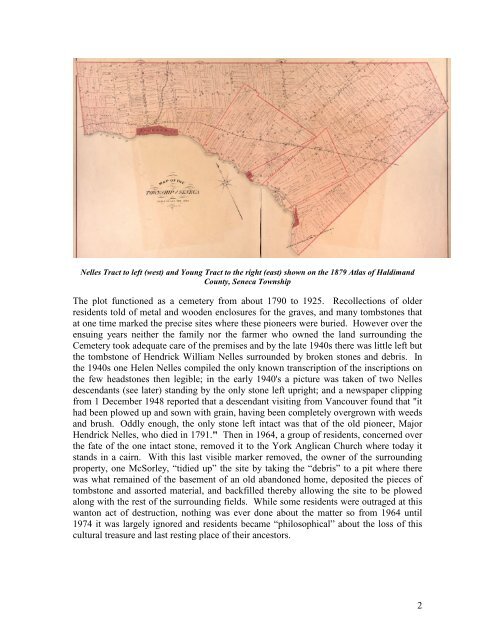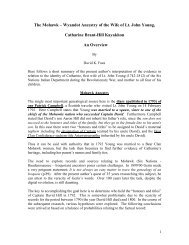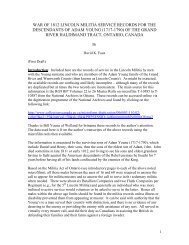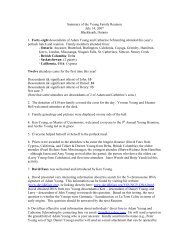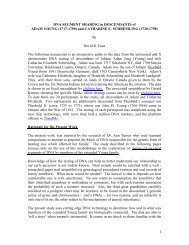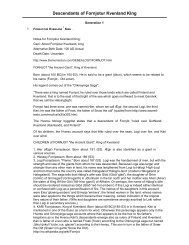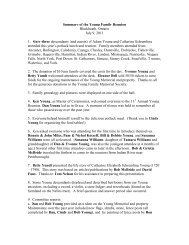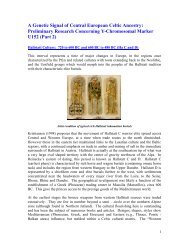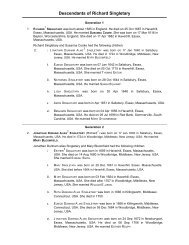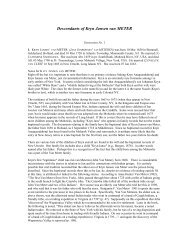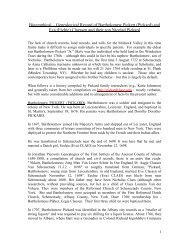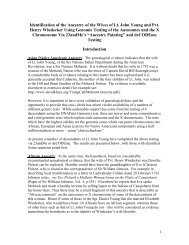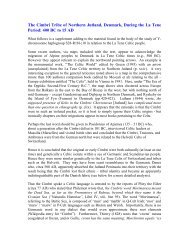the young tract burying ground 1790 â 1925 - Davidkfaux.org
the young tract burying ground 1790 â 1925 - Davidkfaux.org
the young tract burying ground 1790 â 1925 - Davidkfaux.org
Create successful ePaper yourself
Turn your PDF publications into a flip-book with our unique Google optimized e-Paper software.
Nelles Tract to left (west) and Young Tract to <strong>the</strong> right (east) shown on <strong>the</strong> 1879 Atlas of HaldimandCounty, Seneca TownshipThe plot functioned as a cemetery from about <strong>1790</strong> to <strong>1925</strong>. Recollections of olderresidents told of metal and wooden enclosures for <strong>the</strong> graves, and many tombstones thatat one time marked <strong>the</strong> precise sites where <strong>the</strong>se pioneers were buried. However over <strong>the</strong>ensuing years nei<strong>the</strong>r <strong>the</strong> family nor <strong>the</strong> farmer who owned <strong>the</strong> land surrounding <strong>the</strong>Cemetery took adequate care of <strong>the</strong> premises and by <strong>the</strong> late 1940s <strong>the</strong>re was little left but<strong>the</strong> tombstone of Hendrick William Nelles surrounded by broken stones and debris. In<strong>the</strong> 1940s one Helen Nelles compiled <strong>the</strong> only known transcription of <strong>the</strong> inscriptions on<strong>the</strong> few headstones <strong>the</strong>n legible; in <strong>the</strong> early 1940's a picture was taken of two Nellesdescendants (see later) standing by <strong>the</strong> only stone left upright; and a newspaper clippingfrom 1 December 1948 reported that a descendant visiting from Vancouver found that "ithad been plowed up and sown with grain, having been completely overgrown with weedsand brush. Oddly enough, <strong>the</strong> only stone left intact was that of <strong>the</strong> old pioneer, MajorHendrick Nelles, who died in 1791." Then in 1964, a group of residents, concerned over<strong>the</strong> fate of <strong>the</strong> one intact stone, removed it to <strong>the</strong> York Anglican Church where today itstands in a cairn. With this last visible marker removed, <strong>the</strong> owner of <strong>the</strong> surroundingproperty, one McSorley, “tidied up” <strong>the</strong> site by taking <strong>the</strong> “debris” to a pit where <strong>the</strong>rewas what remained of <strong>the</strong> basement of an old abandoned home, deposited <strong>the</strong> pieces oftombstone and assorted material, and backfilled <strong>the</strong>reby allowing <strong>the</strong> site to be plowedalong with <strong>the</strong> rest of <strong>the</strong> surrounding fields. While some residents were outraged at thiswanton act of destruction, nothing was ever done about <strong>the</strong> matter so from 1964 until1974 it was largely ignored and residents became “philosophical” about <strong>the</strong> loss of thiscultural treasure and last resting place of <strong>the</strong>ir ancestors.2


